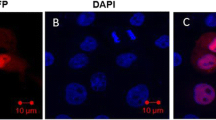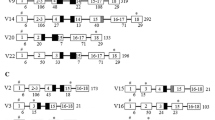Abstract
Tumor necrosis factor alpha-induced protein 8-like 2 (TNFAIP8L2) is a new member of the tumor necrosis factor-α-induced protein 8 (TNFAIP8) family that functions as an important factor in the maintenance of immune homeostasis. In this study, we cloned the cDNA sequences and analyzed the genomic structure of porcine TNFAIP8L2. RH mapping using the IMpRH panel showed that this gene was closely linked to microsatellite marker SW512 in pig chromosome 4. Subcellular localization analysis showed GFP–TNFAIP8L2 fusion protein distributed in nucleus as well as cytoplasm including mitochondria and endoplasmic reticulum. Real-time PCR analysis revealed that porcine TNFAIP8L2 was more highly expressed in spleen than other tissues. To understand its characterization of transcriptional regulation, we cloned approximately 2 kb of 5′-regulatory region upstream to the porcine TNFAIP8L2 translational start site and generated sequential deletion constructs evaluated in dual-luciferase reporter assay. The results demonstrated that its core promoter is 435 base pairs (bp) upstream to the transcription initiation site. Then, site-directed mutation experiment combined with electrophoretic mobility shift assay (EMSA) indicated that M-CAT binding factor (MCBF) and activator protein 1 (AP-1) were important transcription factors for porcine TNFAIP8L2. These findings provide an important basis for further understanding of porcine TNFAIP8L2 regulation and function in swine.










Similar content being viewed by others
References
Aihara Y, Kurabayashi M, Saito Y, Ohyama Y, Tanaka T, Takeda S, Tomaru K, Sekiguchi K, Arai M, Nakamura T, Nagai R (2000) Cardiac ankyrin repeat protein is a novel marker of cardiac hypertrophy: role of m-cat element within the promoter. Hypertension 36(1):48–53
Andersson-Eklund L, Marklund L, Lundstrom K, Haley CS, Andersson K, Hansson I, Moller M, Andersson L (1998) Mapping quantitative trait loci for carcass and meat quality traits in a wild boar × large white intercross. J Anim Sci 76(3):694–700
Angel P, Karin M (1991) The role of jun, fos and the ap-1 complex in cell-proliferation and transformation. Biochim Biophys Acta 1072(2–3):129–157
Chow G, Knudson W (2005) Characterization of promoter elements of the human hyal-2 gene. J Biol Chem 280(29):26904–26912
Eferl R, Wagner EF (2003) Ap-1: a double-edged sword in tumorigenesis. Nat Rev Cancer 3(11):859–868
Fabre-Suver C, Hauschka SD (1996) A novel site in the muscle creatine kinase enhancer is required for expression in skeletal but not cardiac muscle. J Biol Chem 271(9):4646–4652
Farrance IK, Mar JH, Ordahl CP (1992) M-cat binding factor is related to the sv40 enhancer binding factor, tef-1. J Biol Chem 267(24):17234–17240
Freundt EC, Bidere N, Lenardo MJ (2008) A different tipe of immune homeostasis. Cell 133(3):401–402
Genini S, Delputte PL, Malinverni R, Cecere M, Stella A, Nauwynck HJ, Giuffra E (2008) Genome-wide transcriptional response of primary alveolar macrophages following infection with porcine reproductive and respiratory syndrome virus. J Gen Virol 89(Pt 10):2550–2564
Hiraiwa H, Sawazaki T, Suzuki K, Fujishima-Kanaya N, Toki D, Ito Y, Uenishi H, Hayashi T, Awata T, Yasue H (2003) Elucidation of correspondence between swine chromosome 4 and human chromosome 1 by assigning 27 genes to the imprh map, and development of microsatellites in the proximity of 14 genes. Cytogenet Genome Res 101(1):84–89
Humbert O, Achour I, Lautier D, Laurent G, Salles B (2003) Hmsh2 expression is driven by ap1-dependent regulation through phorbol-ester exposure. Nucleic Acids Res 31(19):5627–5634
Jalava A, Mai S (1994) Fos and jun form cell specific protein complexes at the neuropeptide tyrosine promoter. Oncogene 9(8):2369–2375
Karin M, Liu Z, Zandi E (1997) Ap-1 function and regulation. Curr Opin Cell Biol 9(2):240–246
Kumar D, Whiteside TL, Kasid U (2000) Identification of a novel tumor necrosis factor-alpha-inducible gene, scc-s2, containing the consensus sequence of a death effector domain of fas-associated death domain-like interleukin-1beta-converting enzyme-inhibitory protein. J Biol Chem 275(4):2973–2978
Kumar D, Gokhale P, Broustas C, Chakravarty D, Ahmad I, Kasid U (2004) Expression of scc-s2, an antiapoptotic molecule, correlates with enhanced proliferation and tumorigenicity of mda-mb 435 cells. Oncogene 23(2):612–616
Li D, Song L, Fan Y, Li X, Li Y, Chen J, Zhu F, Guo C, Shi Y, Zhang L (2009) Down-regulation of tipe2 mrna expression in peripheral blood mononuclear cells from patients with systemic lupus erythematosus. Clin Immunol 133:422–427
Mar JH, Ordahl CP (1990) M-cat binding factor, a novel trans-acting factor governing muscle-specific transcription. Mol Cell Biol 10(8):4271–4283
Marklund L, Nystrom PE, Stern S, Andersson-Eklund L, Andersson L (1999) Confirmed quantitative trait loci for fatness and growth on pig chromosome 4. Heredity 82(Pt 2):134–141
McWhinney C, Robishaw JD (2008) Myocyte-specific m-cat and mef-1 elements regulate g-protein gamma 3 gene (gamma3) expression in cardiac myocytes. DNA Cell Biol 27(7):367–376
Milan D, Hawken R, Cabau C, Leroux S, Genet C, Lahbib Y, Tosser G, Robic A, Hatey F, Alexander L, Beattie C, Schook L, Yerle M, Gellin J (2000) Imprh server: an rh mapping server available on the web. Bioinformatics 16(6):558–559
Patel S, Wang FH, Whiteside TL, Kasid U (1997) Identification of seven differentially displayed transcripts in human primary and matched metastatic head and neck squamous cell carcinoma cell lines: implications in metastasis and/or radiation response. Oral Oncol 33(3):197–203
Sun H, Gong S, Carmody RJ, Hilliard A, Li L, Sun J, Kong L, Xu L, Hilliard B, Hu S, Shen H, Yang X, Chen YH (2008) Type2, a negative regulator of innate and adaptive immunity that maintains immune homeostasis. Cell 133(3):415–426
Tu SP, Chi AL, Ai W, Takaishi S, Dubeykovskaya Z, Quante M, Fox JG, Wang TC (2009) P53 inhibition of ap1-dependent tff2 expression induces apoptosis and inhibits cell migration in gastric cancer cells. Am J Physiol 297(2):G385–G396
Valmiki MG, Ramos JW (2009) Death effector domain-containing proteins. Cell Mol Life Sci 66(5):814–830
Walling GA, Archibald AL, Cattermole JA, Downing AC, Finlayson HA, Nicholson D, Visscher PM, Walker CA, Haley CS (1998) Mapping of quantitative trait loci on porcine chromosome 4. Anim Genet 29(6):415–424
Walling GA, Visscher PM, Andersson L, Rothschild MF, Wang L, Moser G, Groenen MA, Bidanel JP, Cepica S, Archibald AL, Geldermann H, de Koning DJ, Milan D, Haley CS (2000) Combined analyses of data from quantitative trait loci mapping studies. Chromosome 4 effects on porcine growth and fatness. Genetics 155(3):1369–1378
Woodward MJ, de Boer J, Heidorn S, Hubank M, Kioussis D, Williams O, Brady HJ (2009) Tnfaip8 is an essential gene for the regulation of glucocorticoid-mediated apoptosis of thymocytes. Cell Death Differ 17:316–323
Yerle M, Pinton P, Robic A, Alfonso A, Palvadeau Y, Delcros C, Hawken R, Alexander L, Beattie C, Schook L, Milan D, Gellin J (1998) Construction of a whole-genome radiation hybrid panel for high-resolution gene mapping in pigs. Cytogenet Cell Genet 82(3–4):182–188
You Z, Ouyang H, Lopatin D, Polver PJ, Wang CY (2001) Nuclear factor-kappa b-inducible death effector domain-containing protein suppresses tumor necrosis factor-mediated apoptosis by inhibiting caspase-8 activity. J Biol Chem 276(28):26398–26404
Zhang C, Chakravarty D, Sakabe I, Mewani RR, Boudreau HE, Kumar D, Ahmad I, Kasid UN (2006) Role of scc-s2 in experimental metastasis and modulation of vegfr-2, mmp-1, and mmp-9 expression. Mol Ther 13(5):947–955
Zhang X, Wang J, Fan C, Li H, Sun H, Gong S, Chen YH, Shi Y (2009) Crystal structure of tipe2 provides insights into immune homeostasis. Nat Struct Mol Biol 16(1):89–90
Acknowledgment
This research was funded by National Natural Science Foundation of China (Grant No. U0731003) and National Key Basic Research Plan (973 Project) (Grant No. 2006CB102101).
Author information
Authors and Affiliations
Corresponding author
Additional information
Communicated by L. Andersson.
Rights and permissions
About this article
Cite this article
Li, A., Chen, Y., Zhao, X. et al. Characterization and transcriptional regulation analysis of the porcine TNFAIP8L2 gene. Mol Genet Genomics 284, 185–195 (2010). https://doi.org/10.1007/s00438-010-0558-z
Received:
Accepted:
Published:
Issue Date:
DOI: https://doi.org/10.1007/s00438-010-0558-z




